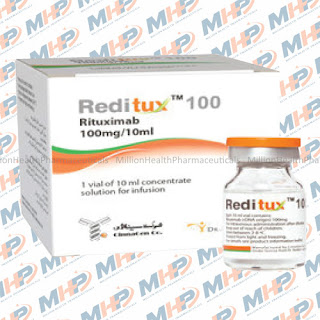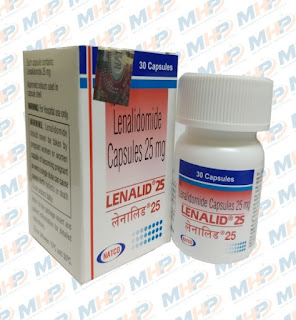REDITUX-100MG-INJECTION
Drug profile of Reditux
Reditux is not chemotherapy, it is a monoclonal antibody
Reditux injection contains an active substance known as Rituximab, which is used to treat certain types of cancers and also to treat some auto immune diseases.
Reditux is a prescription medicine, used by the patients who are having a valid prescription and used only under the guidance of practiced medical oncologist.
Reditux is an antibody therapy which is used to improve the immune system of suspected patient and provide immunity against the disease.
Reditux is used very cautiously with maintaining the dosing management prescribed by oncologist.
Reditux injection should be used by the patient only after getting counsel about the serious illness occurrence during the therapy.
 |
REDITUX-100MG-INJECTION |
Rituximab is a biological drug which is a monoclonal antibody aimed against CD20 antigen which is present on surface of both healthy and tumor affected cells.
Rituximab is applicable in injection form with the strength of 500mg & 100mg
Reditux 500mg contains 50ml of solution containing 500mg of rituximab as a drug.
Reditux 100mg contains 10ml of solution containing 100mg of rituximab as a drug.
Prescribing information of Reditux
Reditux is majorly indicated in adolescent patients.
The therapeutic indication of Reditux;
Non Hodgkin’s lymphoma:
In this condition, Reditux is only indicated in adult patients with;
Intensifying, second rate or follicular, CD20 positive, B cell NHL as a solitary specialist.
Once in the past natural follicular, CD20 positive B cell NHL in attendant with first line therapy and in persistent achieving a total or constrained reaction to Reditux by joining with chemotherapy as a solitary operator continuation treatment.
Un-preparing second rate CD20 positive B cell NHL as a solitary operator after first line cyclophosphamide, vincristine and prednisolone treatment.
Synchronous with cyclophosphamide, doxorubicin, vincristine, prednisolone or some other anthracycline based regimens, Once in the past non-treated diffuse big B cell CD20 positive B cell NHL in
Advanced lymphocytic leukemia:
Reditux is involved in this condition by combining with fludarabine & cyclophosphamide only applicable in adult patients with formerly untreated & treated CD20 positive CLL.
Rheumatoid arthritis:
In this condition, Reditux is used in combination of methotrexate. This may applicable for adult patient with moderate or severe active RA & who are having inadequacy response to one or more TNF antagonist treatments.
Granulomatosis with polyangiitis:
This condition should be treated by using Reditux by concurrently used with corticosteroids.
Pemphigus vulgaris:
Reditux is also used to treat this condition which is either moderate or severe stage.
Mechanism of Reditux
Reditux is an anti-body therapy which is improving the immunity and fighting against the suspected disease condition.
Rituximab is pharmacologically classified as monoclonal antibody, which aimed the CD20 antigen which exists on the surface of the pre B & completely developed B lymphocytes.
After binding of rituximab with CD20 antigen site, cell eruption occurs.
The most probably cell lysis mechanism is;
Complement dependent cytotoxicity
Antibody dependent cell mediated cytotoxicity.
Non Hodgkin’s lymphoma:
After IV infusion of Reditux 375mg/m2 weekly for 4 doses, the rituximab is present is serum of patients 3 to 6 months after conclusion of treatment.
When administration of 375mg/m2 of Reditux as 6 infusions by combining with 6 cycles of CHOP chemotherapy, the pharmacokinetic profile of rituximab is similar in combinational study to seen with rituximab alone.
In NHL, the terminal half life period of Reditux is 32 days with the range of 14 to 62 days.
In chronic lymphocytic leukemia, the terminal half life period is 32 days with the range of 14 to 62 days.
In RA, after 2 infusions of Reditux causes, Cmax value of 1st & 2nd is 157 & 183 mcg/ml
The volume of distribution is 3.1L
The mean terminal half life is 18 days.
In granulomatosis with polyangiitis, the mean terminal half life period is 23 days and means clearance & volume of distribution is 0.312L/day & 4.50L.
When to take the Reditux
The route of administration of Reditux is only applicable through intravenous infusion, not through IV push or bolus.
To overcome the infusion reactions, Reditux should be administered only tby the medical practitioner with medical support.
Premedication should be given for the suspected patients for avoiding the infusion reactions.
Before first infusion:
Before starting the infusion of Reditux, patient should be monitored by measuring the HBsAg & anti-HBc counts for avoiding the hepatitis B infection occurrence.
Complete blood cell counts should be taken.
During the treatment with Reditux;
In lymphoid virulence, during Reditux therapy patient should be completely checked by counting the blood cells.
During Reditux treatment, CBC should be recommended.
In 1st infusion: The rate of infusion at first time is suggested as 50mg/hr, in case of absence of infusion toxicity the rate of infusion should be increased by 100mg/hr. at 30 minutes intervals.
The maximum rate of infusion is 400mg/hr.
Following infusions:
Initial rate of infusion is 100mg/hr, followed by absence of infusion toxicity the rate should be elevate by 100mg/hr at 30 minutes intervals.
Maximum rate is 400mg/hr.
Formerly untreated follicular NHL & DLBCL patients:
Patient did not accomplish with grade 3 or 4 infusion related adverse effects during cycle 1, a 90 minute infusion should be followed in cycle 2 by administering glucocorticoid containing regimen.
At first 20% of dose should be given in 30 minutes
At second remaining 80% of dose should be given over 60 minutes.
If Patient suffered with cardiac problems or their circulating lymphocytes counts ≥ 5000/mm3 before the 2nd cycle, then infusion rate period over 90 minutes should not be recommended.
Postpone the infusion cycle and slows down the rate of infusion and resume the infusion rate after improvement of symptoms.
Dosage regimens of Reditux
In non Hodgkin’s lymphoma:
The advised dose of Reditux for this condition is 375mg/m2 should be administered as a IV infusion.
In relapsed low grade follicular CD20 B cell NHL:
Reditux should be administered as once a week for 4 doses or 8 doses.
Re-therapy for relapsed low grade follicular CD20 positive B cell NHL:
Reditux should be administered as once a week for 4 doses.
Formerly untreated follicular CD20 positive B cell NHL:
On day 1, administer the doses of Reditux up to 8 doses. In complete or limited response, start Reditux treatment continuance of 8 weeks following conclusion of Reditux therpy by combining with other chemo regimen.
Reditux should be administered as a single agent for every 8 weeks as 12 doses.
Un-processing low grade CD20 positive B cell NHL after CVP therapy;
Conclusion of 6 to 8 cycles of CVP therapy, administer Reditux as once a week for 4 doses at 6 month interval to higher of 16 doses.
Large B cell NHL:
On day 1 of each cycle of chemotherapy should be administer for maximum 8 infusions.
Chronic lymphocytic leukemia;
The prescribed dose of Reditux is 375mg/m2 should be administered before starting the FC chemo treatment. Then resume to 500mg/m2 on day 1 of cycles 2 to 6 (every 28 days).
In RA;
The prescribed dose of Reditux is two 1000mg IV infusion separated by 2 weeks.
Reditux combined with methotrexate for this condition.
In granulomatosis with polyangiitis;
The prescribed dose of Reditux is 375mg/m2 given as IV infusion as once weekly for 4 weeks.
Pemphigus vulgaris:
Reditux should be administered as 2 1000mg doses through IV infusion by 2 weeks in combination of glucocorticoid.
Premedications:
Before starting the infusion of Reditux, patient should be given with acetaminophene & anti-histamine.
On 90 minutes infusion, before starting the infusion patient should be treayed with glucocorticoid.
In RA & PV patients, the premed is methyl prednisolone as 10mg dose through IV
In GPA & MPB patients, Reditux should be combined with glucocorticoid
Administration:
The solution from Reditux vial should be withdrawn aseptically and diluted into 0.9% sodium chloride or 5% dextrose.
Discard the unused portion of Reditux vial.
Do not mix the Reditux into other drugs.
Storage:
Reditux solution should be stored at 2oC to 8oC for 24 hours.
The solution should be stable for 24 hours by keeping at room temperature.
Reditux solution should not contain any preservatives; it should be kept in fridge temperature.
There is no compatibility between Reditux & polyvinyl chloride or polyethylene bags.
Reditux caused side effects
The most common serious effects during the Reditux treatment;
Infusion reactions
Serious Mucocutaneous reactions
Aggravation of hepatitis B reactivation
Multifocal leukoencephalopathy
Tumor lysis syndrome
Cardiovascular adverse reactions
Renal toxicity
Bowel obstruction & perforation
Common side effects;
Fever
Chills
Infection
Asthenia
Headache
Abdominal pain
Pain
Back pain
Throat irritation
Flushing
Lymphopenia
Leucopenia
Neutropenia
Thrombocytopenia
Anemia
Night sweats
Rash
Pruritus
Urticaria
Cough
Rhinitis
Bronchospasm
Dyspnea
Sinusitis
Angioedema
Increased blood glucose
LDH increase
Edema
Myalgia
Arthralgia
Hypotension
Post marketing reports;
Pancytopenia
Extended hypogammaglobulinemia
Cardiac failure
Auto immune disorders
Kaposi’s sarcoma
GI perforations
Broncholitis, interstitial lung disease
PRES/RPLS
Drug- drug interaction
A drug interaction has not been evaluated during this treatment.
In chronic lymphocytic leukemia, Reditux did not cause any variation in systemic exposutre to fludarabine or cyclophosphamide.
In RA, there is no pharmacokinetic alteration occurs while concomitant use of redirux with methotrexate or cyclophosphamide.
Food drug interaction
Diet should be followed by getting advice from the physician and follow the diet chart.
Possible contraindications
No possible contraindications present.
An anaphylactic reaction may occur, if patients are contraindicated to the component presentin the Reditux.
Some infusion reactions are produced during administration
Safety measures
Infusion reactions: During treatment by using Reditux some fatal infusion reactions are produced, that may leads to serious effects.
To overcome this problem, patients before starting the infusion premedication should be recommended.
In severe condition, stop the infusion and provide supportive measures.
Serious Mucocutaneous reactions: Discontinue the Reditux therapy.
Hepatitis B reactivation: To overcome the problem patient should be examine by measuring both HBsAg & anti-HBc counts before initiating the treatment.
In severe condition, Reditux treatment should be postponed or discontinued/.
Multifocal leukoencephalopathy: The major risk occurs in this effect is death. Hematological malignancies are produced. Stop the problem by discontinuing the Reditux treatment.
Tumor lysis syndrome: Correct the electrolyte balance, monitor the renal functions, patient should be provided with supportive measures.
Infections: For resolved this condition, anti-infective treatment should be followed and in severe condition Reditux treatment should be stopped and provide supportive management.
CVS disorders: Monitor the cardiac functions frequently during the infusion of Reditux, and give general supportive measures.
Renal toxicity: Severe renal toxicity may occur during the therapy with Reditux. The concomitant use of Reditux with cisplatin should not be recommended. Monitor the manifestation due to renal toxicity and stop the Reditux treatment in the patients with high risk of creatinine or oliguria.
Bowel obstruction & perforation: This fatal cases leads to death, the manifestation associated with GI perforation should be monitored.
Embryo fetal toxicity: Reditux should be contraindicated to pregnancy condition
Pregnancy and lactation
Pregnancy category of Reditux is C
Reditux should not be applicable to pregnancy and lactating period.
Storage and handling
Reditux vial should be stored at 2oC to 8oC
Protect the vial from moisture, heat & light.
Missed dose
If patient fail to take the cycle of Reditux, must be consult with medical oncologist and follow the instructions.
Patient should be following the regular chemotherapy cycles without fail.
Over dosage
Over dosage should not be possible during Reditux treatment.
In case of missing cycles during the chemotherapy, should be consult with medical oncologist.



Comments
Post a Comment